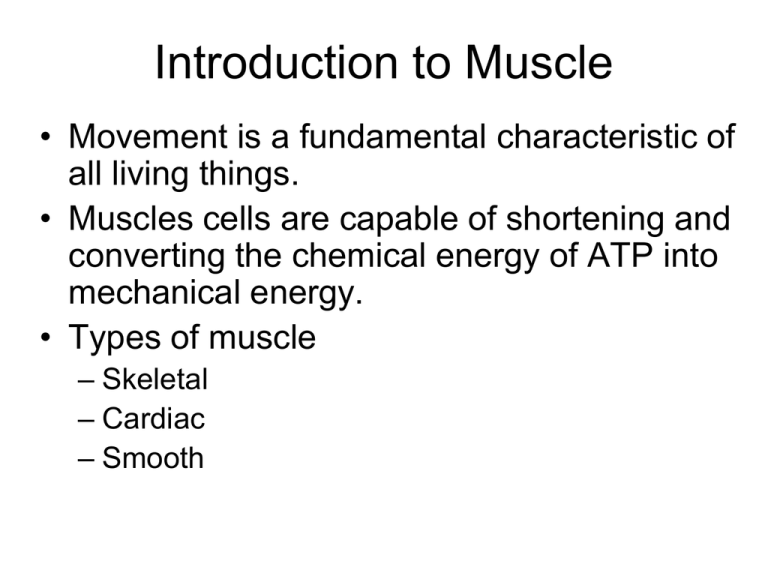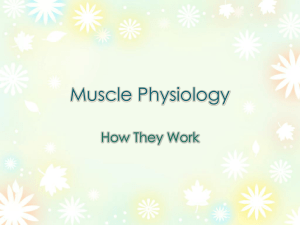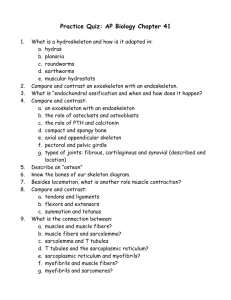Introduction to Muscle
advertisement

Introduction to Muscle • Movement is a fundamental characteristic of all living things. • Muscles cells are capable of shortening and converting the chemical energy of ATP into mechanical energy. • Types of muscle – Skeletal – Cardiac – Smooth Skeletal Muscle – Has obvious stripes called striations and multiple nucleuses – Under voluntary control • Attached to the skeletal system • Responsible for movement. Cardiac Muscle • Striated muscle but is involuntary • Intercalated discs connect adjacent cells together Smooth Muscle • Found in the walls of hollow visceral organs, such as the stomach, intestines ,bladder. – It is not striated and is involuntary Characteristics of Muscle Tissue • Excitability, or responsiveness – the ability to respond to stimuli • Conductivity – the ability to produce and conduct an action potential along the cell membrane • Contractility – the ability to shorten creates movement by: • Skeletal: pulling on bones • Visceral: Movement created by visceral organs. • Extensibility – the ability to be stretched • Elasticity – the ability to recoil after being stretched Connective Tissues of a Muscle Tendon Deep fascia Epimysium Perimysium Endomysium Skeletal Muscle • Each muscle is composed of various tissue types. They include muscle tissue, blood vessels, nerve fibers, and connective tissue. • The connective tissue located is important for supplying a framework for the blood vessels and nerves. They also contribute to the elastic qualities of muscle aiding in force production. • The three connective tissue sheaths are: – Endomysium – fine sheath of connective tissue surrounding each muscle fiber – Perimysium –connective tissue that surrounds groups of muscle fibers called fascicles – Epimysium – an overcoat of dense regular connective tissue that surrounds the entire muscle The Muscle Fiber Anatomy of a Skeletal Muscle Fiber • Each fiber is surrounded by a sarcolemma • ( cell membrane around the muscle) – the sarcolemma contains voltage-gated channels able of generating an action potential – The action potential travels along the sarcolemma and dips into the center of the muscle via transverse-tubules. (T-tubules) • Sarcoplasmic reticulum (SR) (bathes the muscle fibers) – Extensions of the T-tubules which store intracellular calcium (Ca+2) • Once an action potential reaches the T-tubules Ca+2 from the terminal cysterna of SR is released into the sarcoplasm triggering a muscle contraction. Myofilaments: Banding Pattern Myofilaments: Banding Pattern The thin and thick filaments overlapping forming sarcomeres. • Z disc – anchors the thin filaments and connects myofibrils to one another – Z-disc to Z disc = one sarcomere • A band – the length of the thick filaments • I band – the length of thin filaments within a sarcomere that is not overlapping with the thick filaments • H zone – the length of thick filaments within in a sarcomere that do not overlapping with the thin filaments Resting Muscle • When a muscle is in a relaxed state the sarcomere is at its normal length. • The H-zone is visible. Contracted Sarcomeres • Muscle cells shorten because their individual sarcomeres shorten as myosin pulls actin toward the center of the sarcomere. – pulling Z discs closer together • Notice neither thick nor thin filaments change length they overlap as sarcomeres shorten • H-zone disappears Resting muscle/Contracted muscles Thick Filaments • Arranged in a bundle with heads directed outward in a spiral array • Myosin heads: – Form cross bridges with actin. – Myosin contains the enzyme ATPase which hydrolyzes ATP to create movement. Thin Filaments • Actin: Two intertwined strands fibrous protein containing the active site for myosin heads. • Tropomyosin : Prevents actin and myosin cross bridge formation • Troponin: a protein attached to tropomyosin that calcium binds to allowing cross bridge formation and muscle contraction. The Neuromuscular Junction Neuromuscular Junctions (Synapse) • Functional connection between nerve fiber and muscle cell • Neurotransmitter (acetylcholine/ACh) released from nerve fiber stimulates muscle cell • Components of synapse (NMJ) – synaptic knob is swollen end of nerve fiber (contains ACh) – junctional folds region of sarcolemma • increases surface area for ACh receptors • contains acetylcholinesterase that breaks down ACh and causes relaxation – synaptic cleft = tiny gap between nerve and muscle cells Electrically Excitable Cells • Plasma membrane is polarized or charged – resting membrane potential due to Na+ outside of cell and K+ and other anions inside of cell – difference in charge across the membrane = resting membrane potential (-90 mV cell) • Stimulation opens ion gates in membrane – ion gates open (Na+ rushes into cell and K+ rushes out of cell) • quick up-and-down voltage shift = action potential – spreads over cell surface as nerve signal Excitation (Steps 1 and 2) • AP opens voltage-gated calcium channels. Calcium stimulates exocytosis of synaptic vesicles containing ACh = ACh release into synaptic cleft. Excitation (steps 3 and 4) Binding of ACh to receptor proteins opens Na+ and K+ channels resulting in jump in RMP from -90mV to +75mV forming an end-plate potential (EPP). Excitation (step 5) Voltage change in end-plate region (EPP) opens nearby voltage-gated channels producing an action potential Excitation-Contraction Coupling (steps 6 and 7) Action potential spreading over sarcolemma enters T tubules -- voltage-gated channels open in T tubules causing calcium gates to open in SR Excitation-Contraction Coupling (steps 8 and 9) • Calcium released by SR binds to troponin • Troponin-tropomyosin complex changes shape and exposes active sites on actin Contraction (steps 10 and 11) • Myosin ATPase in myosin head hydrolyzes an ATP molecule, activating the head and “cocking” it in an extended position • It binds to actin active site forming a cross-bridge Contraction (steps 12 and 13) • Power stroke = creates muscle contraction – myosin head pulls the actin over it. – With the binding of more ATP, the myosin head will detach and break the cross bridge. Relaxation (steps 14 and 15) Nerve stimulation ceases and acetylcholinesterase removes ACh from receptors. Stimulation of the muscle cell ceases. Relaxation (step 16) • Active transport needed to pump calcium back into SR to bind to calsequestrin • ATP is needed for muscle relaxation as well as muscle contraction Relaxation (steps 17 and 18) • Loss of calcium from sarcoplasm moves troponin-tropomyosin complex over active sites – Muscle fiber returns to its resting length Motor Units • A motor neuron and the muscle fibers it innervates. • Fine control – small motor units contain as few as 20 muscle fibers per nerve fiber – eye muscles • Allow for greater dexterity because of a lower neuron to muscle fiber ratio. • Strength control – gastrocnemius muscle has 1000 fibers per nerve fiber • One motor neuron controls many muscle fibers which allows for strength production. Recruitment and Stimulus Intensity • Strength of muscle contraction is dependant of # of motor units recruited • Multiple motor unit summation – The harder the activity is the more motor units will be recruited. • Lifting 1 lb vs. 100 lbs – How do you explain the rapid strength gains when you first start training? Muscle Twitch • A single stimulus results in a single muscle twitch • Each twitch has time to recover but develops more tension than the one before (treppe phenomenon) Muscle Response: Stimulation Frequency • Higher frequency stimulation generates gradually more strength – each stimuli arrives before last one recovers • temporal summation or wave summation – incomplete tetanus = sustained fluttering contractions • Maximum frequency stimulation – muscle has no time to relax at all – twitches fuse into smooth, prolonged contraction called complete tetanus Isometric and Isotonic Contractions • Isometric muscle contraction – develops tension without changing length – important in postural muscle function and antagonistic muscle joint stabilization • Isotonic muscle contraction – tension while shortening = concentric – tension while lengthening = eccentric Metabolism and Skeletal Muscle Fibers Types • There are 3 different types skeletal muscle fibers based histological differences, duration of a twitch and the method of ATP production – slow oxidative fibers – fast oxidative fibers – fast glycolytic fibers • Proportions genetically determined Fast Glycolytic, Fast-Twitch Fibers • Fast glycolytic, fast-twitch fibers: – rich in enzymes for phosphagen and glycogen-lactic acid systems – Limited # of mitochondria and high concentration of glycogen stores makes it adapted for anaerobic metabolism • a lack of myoglobin in glycolytic fibers results in a white color – sarcoplasmic reticulum releases calcium quickly so contractions are quicker which are required for movements that produce speed and power. • extraocular eye muscles, gastrocnemius and biceps brachii Slow- Twitch Fibers • Slow oxidative, slow-twitch fibers – Oxidative fibers contain greater amounts of mitochondria and myoglobin which binds oxygen. – Rich blood supply and high concentration of myoglobin these fibers appear red in color. • adapted for endurance (resistant to fatigue) – Soleus and postural muscles of the back are predominantly this type. Fast Oxidative Fibers • Fast oxidative fibers: – characteristics of both fast and slow fibers. – have a fast twitch (use ATP quickly) – Increased mitochondria make it moderately resistant to fatigue – Usually make up 10% of fibers. • Training will make these fibers adapt to become functionally more fast or slow. Cellular Adaptations to Physical Demands • Strength training: high intensity training stresses anaerobic pathways. – Increased # and size of glycolytic associated enzymes and substrates • ATP, creatine phosphate and glycogen • Endurance training: Enhance the aerobic pathways. – increased # and size of mitochondrial membranes and associated enzymes. – This will increase O2 uptake ( VO2 max) which will delay the formation of lactic acid.






